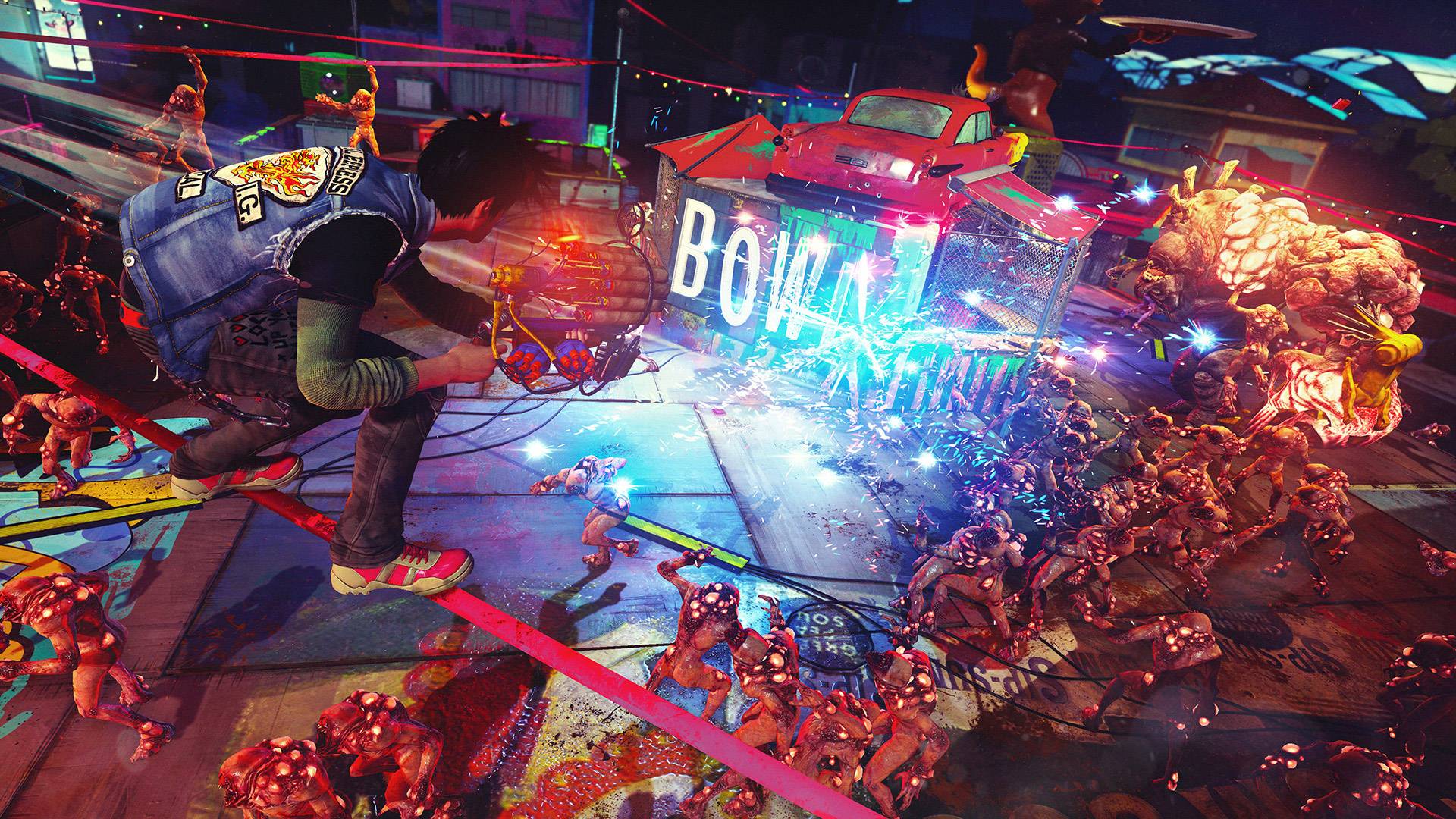Insomniac Has Done Open World Before… It’s Called Sunset Overdrive
The world-building that eventually led to Spider Man

As two great additions to Marvel Comics’ gaming library, both Spider-Man (2018) and Spider-Man: Miles Morales have seen celebration from the wider gaming community. Not only do the two games present fans with some of the best storytelling featuring the two web slingers, but the open-world design featured in both games is known to be an immersive recreation of New York City. However, Peter Parker and Miles Morales’ adventures were not Insomniac’s first open-world titles; that honor belongs to Sunset Overdrive (2014).
Prior to Sunset, Insomniac had been mostly known for creating Spyro as well as Ratchet and Clank series, both of which belonged to the 3D platform genre that had dominated the console market during the early 2000s. In between Insomniac’s Spyro and Ratchet outings were shooter games such as the Resistance series and Fuse, which made the open-world genre seem like uncharted territory for the Burbank-based studio at the time.
Enter Sunset Overdrive in 2014, a fresh take on the post-apocalyptic genre with punk rock influences. Unlike most post-apocalyptic games that feature bleak and grim undertones, Sunset’s tone is fun and lackadaisical, further reinforced with its colorful and vibrant art style. Its open-world map design manages to complement its art direction as well as the game’s (and later Insomniac’s) powerful in-game feature: traversal.
Traversing across the map of Sunset City is fun and engaging, which may have set the precedent for Insomniac’s superb take on web-swinging in its Spider-Man games. Players can grind on railings and fences, bounce off cars and parasols, air-dash, pole-vault past light posts, and wall-run even on curved walls. The game’s lack of a sprint function combined with the fact that all types of enemies will decimate the comparatively sluggish player on foot underlines the importance of these navigational features.
Though not to worry for the players, the open world of Sunset has traversing options in spades scattered throughout the map. Points of grinding, bouncing, pole-vaulting and wall-running are evenly spaced and measured from each other which allows for experiments and quick switches on the fly, even during combat. Responsive and easy-to-learn controls found in Sunset are useful in chaining together tricks that are an integral part of combat in the game, which is accommodated by the map’s insane amount of verticality.

Sunset’s momentum-based combat also carries over to its gunplay, which has a refreshing lack of cover system found in most third-person shooter games. Instead of taking cover, players are encouraged to always be on the move, quite literally running (or in the game’s case, grinding) circles around their enemies while cutting them down with wacky weaponry.
Speaking of Sunset’s arsenal, the game features creative weapon designs that do not sacrifice substance, as all weapons are viable against at least one of the four enemy archetypes: zombies, human raiders, killer robots, and mutated zombies. From a grenade launcher that shoots out explosive hair sprays to a gun that deploys corrosive garden sprinklers to a harpoon gun that attracts crowds of zombies, the weapons in Sunset are a joy to look at as much as they are to obliterate enemies.
Then there are also gun augments that add another layer to the gameplay, whether it be setting enemies on fire, stunning them with electricity, or spawning a mini-nuclear bomb after a kill. Other augments such as melee augments that can summon tornadoes or slam augments that send out lethal glass shards as the player slams the ground are not only fascinating to look at but can also act as powerful options during combat. All these augments activate after chaining a certain number of tricks on the landscape, which ties the combat into the traversal system nicely. The same goes for the game’s fast-paced and energetic skate punk soundtrack; the more players trick, the more exciting the music gets.
Meanwhile, in the story department, Sunset is admittedly a bit formulaic; taking the role of an ex-janitor of the corporation responsible for the zombie outbreak in Sunset City, the player must work together with the city’s quirky groups of survivors in order to escape the zombie-infested locale and expose the truth of the incident to the world.
That being said, Sunset’s plot is enjoyable with sprinkles of epic set pieces and smart tongue-in-cheek writing. While it has its dramatic moments, it is clear that the game’s story does not take itself seriously. It may not be as well-written as the Spider-Man games when it comes to character depth and voice performances, but the story can still be considered a solid and enjoyable ride. The mission design, on the other hand, can be a hit-and-miss, especially with some of its side quests boiling down to simple fetch quests with strong storytelling incentives.

Parts of the game’s eccentric personality also bleed into the nameless player character and their interactions with the game, some of which break the fourth wall like it was made of Styrofoam: their load game animation has them literally push the camera backward, the respawning animation has them coming out of a Tardis-esque phone booth, and their dialogue makes fun of the game’s simple, one-button-tap gender change feature. And while the customization for the player character is not as deep as, say, the Saints Row series, it offers a lot of variety alongside a strong sense of the game’s identity found in its take on different fashion subcultures.
Unfortunately despite its engaging traversal system, Sunset’s open-world map lacks immersion. Save for annihilating troves of enemies, doing challenges & finite side quests, and participating in small rescue encounters, there is not a lot to do in Sunset City. While the challenges are fun and make good use of the game’s combat and traversal system, they can wear off their welcome after a while. While not a complete misfire on world-building, the game can definitely benefit from a better open-world design with more varied side quests and random encounters.
Even with all its shortcomings, there is no denying that Sunset Overdrive is an outrageously fun first attempt into the open-world genre that deserves more attention—and it is not hard to do so, since the game is part of the XBOX Game Pass library, available on its native system as well as on PC. Not only that, it also deserves a sequel.
Of course, talks about Sunset’s future are being put on hold with Insomniac’s development of Spider-Man 2 and following that, Wolverine. However, Sunset’s director Marcus Smith has expressed interest in returning to the series back in 2021, saying that “there is nothing really stopping us other than we have a lot of really exciting things in our future”. So, fingers crossed that after Insomniac is done with the adamantium-laced superhero, we can make a return to Sunset City. Call it Midnight Overdrive, perhaps?
